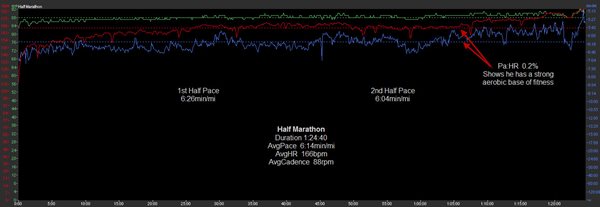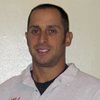With the winter and spring marathon season looming in the near future and the 2012 Olympic Trials set for next week, I thought it would be a good idea to look at the pacing technique, using a recent half marathon as a case study. This half marathon was completed by an athlete client I’ve been working with for some time, and it’s a great example for further elaborating on. I’ve been asked several times since then about pacing strategy, so it must be a concern of many.
Some quick background information on this particular athlete I mentioned above: He’s a seasoned runner with over 20 marathons already under his belt, but he hasn’t PR’ed in several attempts. When I first started working with him he explained his race day strategy, which involved dividing his goal time by 26.2 and then trying to bank 20-30 seconds per mile early for when he knew he would fade at the end. As do so many others, he would often complain about late muscle cramping and hitting the wall. He also noted that his heart rate always seemed high on race day, as one would expect if the pace was too fast in the early part of the race.
It took some effort to convince him to ditch the habit of banking time. To persuade him to consider another approach, I explained to him that fitness was only one variable of the several that would be needed on race day to accomplish his goal. He needed a better race strategy because banking time doesn’t work, and simply dividing the distance by miles doesn’t account for terrain or other factors.
After working with him for some time, he began to see the light and is now on board 100%. To begin ingraining this new pacing approach for him, we started by implementing a specific drill session each week where we honed his running technique for better endurance. In addition, our workouts routinely enforced the conservative start approach. For example, we would start a long run at 1:20 per mile slower than the tempo pace and then increase the pace 20 seconds every 2 miles. This type of workout allowed him to become better used to running fast with fatigued legs while staying relaxed as the pace increased. As a result of our hard work, he no longer is experiencing those late muscle cramps on his long runs, and his confidence is sky-high.
He must remember, though, that even with the fitness we built and the new race strategy, we cannot guarantee success if the plan is not executed come race day. He will not be out there alone doing workouts and drills; there will be thousands of other runners, and his adrenaline will no doubt be high. He must not chase the rabbits running an unsustainable pace but rather be mindful of his goal and the work that’s been done to get him to the start. I have confidence that he will, in fact, reach his goal, and all the indicators in his training are showing that he’s tapering perfectly.
Below is a chart from a recent half marathon this athlete completed where, thanks to the new training and racing strategy, he paced the race perfectly, building his pace from a conservative start and then negatively splitting the overall race. As you can see, he ran the first half of the race 0:12 a mile slower than his overall race pace, and his decoupling rate of 0.2%, as measured by Pa:HR demonstrates a strong aerobic base of fitness thanks to the focused training. (Learn more about decoupling rate and how it measures aerobic efficiency in this article by Joe Friel). He took 4th in his AG on that day.

Remember that fitness is only one piece of the puzzle you need to bring on race day. You need a smart pacing plan developed and proven in training and the faith in that plan to execute it on race day regardless of what those around you are doing.
Happy running!


